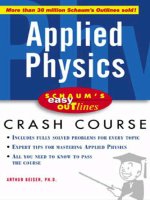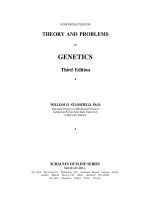- Trang chủ >>
- Khoa Học Tự Nhiên >>
- Vật lý
palen s. schaum''s outline of astronomy
Bạn đang xem bản rút gọn của tài liệu. Xem và tải ngay bản đầy đủ của tài liệu tại đây (4.2 MB, 241 trang )
Theory and Problems of
Astronomy
STACY E. PALEN
Department of Astronomy
University of Washington
Schaum’s Outline Series
McGRAW-HILL
New York Chicago San Francisco Lisbon London Madrid Mexico City
Milan New Delhi San Juan Seoul Singapore Sydney Toronto
Copyright © 2002 by The McGraw-Hill Companies, Inc. All rights reserved. Manufactured in the United States of America. Except as per-
mitted under the United States Copyright Act of 1976, no part of this publication may be reproduced or distributed in any form or by any
means, or stored in a database or retrieval system, without the prior written permission of the publisher.
0-07-139993-3
The material in this eBook also appears in the print version of this title: 0-07-136436-6.
All trademarks are trademarks of their respective owners. Rather than put a trademark symbol after every occurrence of a trademarked
name, we use names in an editorial fashion only, and to the benefit of the trademark owner, with no intention of infringement of the
trademark. Where such designations appear in this book, they have been printed with initial caps.
McGraw-Hill eBooks are available at special quantity discounts to use as premiums and sales promotions, or for use in corporate train-
ing programs. For more information, please contact George Hoare, Special Sales, at or (212) 904-
4069.
TERMS OF USE
This is a copyrighted work and The McGraw-Hill Companies, Inc. (“McGraw-Hill”) and its licensors reserve all rights in and to the
work. Use of this work is subject to these terms. Except as permitted under the Copyright Act of 1976 and the right to store and retrieve
one copy of the work, you may not decompile, disassemble, reverse engineer, reproduce, modify, create derivative works based upon,
transmit, distribute, disseminate, sell, publish or sublicense the work or any part of it without McGraw-Hill’s prior consent. You may
use the work for your own noncommercial and personal use; any other use of the work is strictly prohibited. Your right to use the work
may be terminated if you fail to comply with these terms.
THE WORK IS PROVIDED “AS IS”. McGRAW-HILL AND ITS LICENSORS MAKE NO GUARANTEES OR WARRANTIES AS
TO THE ACCURACY, ADEQUACY OR COMPLETENESS OF OR RESULTS TO BE OBTAINED FROM USING THE WORK,
INCLUDING ANY INFORMATION THAT CAN BE ACCESSED THROUGH THE WORK VIA HYPERLINK OR OTHERWISE,
AND EXPRESSLY DISCLAIM ANY WARRANTY, EXPRESS OR IMPLIED, INCLUDING BUT NOT LIMITED TO IMPLIED
WARRANTIES OF MERCHANTABILITY OR FITNESS FOR A PARTICULAR PURPOSE. McGraw-Hill and its licensors do not
warrant or guarantee that the functions contained in the work will meet your requirements or that its operation will be uninterrupted or
error free. Neither McGraw-Hill nor its licensors shall be liable to you or anyone else for any inaccuracy, error or omission, regardless
of cause, in the work or for any damages resulting therefrom. McGraw-Hill has no responsibility for the content of any information
accessed through the work. Under no circumstances shall McGraw-Hill and/or its licensors be liable for any indirect, incidental, spe-
cial, punitive, consequential or similar damages that result from the use of or inability to use the work, even if any of them has been
advised of the possibility of such damages. This limitation of liability shall apply to any claim or cause whatsoever whether such claim
or cause arises in contract, tort or otherwise.
DOI: 10.1036/0071399933
abc
McGraw-Hill
The purpose of this Outline is to serve as a supplement to a basic astronomy text.
Much of the material here is abbreviated, and students should use this book as a
guide to the key concepts in modern astronomy, but not as an all-inclusive
resource.
Topics covered range from planetary astronomy to cosmology, in the modern
context. The first chapter covers most of the phsyics required to obtain a basic
understanding of astronomical phenomena. The student will most likely come
back to this chapter again and again as they progress through the book. The
order of the topics has been set by the most common order of these topics in
textbooks (near objects to far objects), but many of the chapters are quite inde-
pendent, with few references to previous chapters, and may be studied out of
order.
The text includes many worked mathematical problems to support the efforts of
students who struggle particularly in this area. These detailed problems will help
even mathematically adept students to see how to solve astronomical problems
involving several steps.
I wish to thank the many people who were instrumental to this work, including
the unknown reviewer who gave me so many useful comments, and especially the
editors, Glenn Mott of McGraw-Hill and Alan Hunt of Keyword Publishing
Services Ltd., who guided a novice author with tremendous patience. I also
wish to thank John Armstrong for proofreading the very first (and therefore
very rough!) draft and all my colleagues at the University of Washington who
served as sources of knowledge and inspiration.
S
TACY PALEN
iii
Copyright 2002 The McGraw-Hill Companies, Inc. Click Here for Terms of Use.
This page intentionally left blank.
CHAPTER 1 Physics Facts 1
About Masses 1
About Gases 13
About Light 15
About Distance 25
CHAPTER 2 The Sky and Telescopes 31
Coordinate Systems and Timescales 31
Instrumentation 42
CHAPTER 3 Terrestrial Planets 49
Formation of Terrestrial Planets 50
Evolution of the Terrestrial Planets 53
Mercury 56
Venus 59
Earth 62
Moon 67
Mars 71
Moons of Mars 72
CHAPTER 4 Jovian Planets and Their Satellites 77
Jupiter 78
Saturn 79
Uranus 79
Neptune 80
Moons 81
Rings 87
CHAPTER 5 Debris 91
Comets 91
Meteorites 95
Asteroids 99
Pluto and Charon 103
CHAPTER 6 The Interstellar Medium and Star
Formation 107
The Interstellar Medium 107
Star Formation 117
v
Copyright 2002 The McGraw-Hill Companies, Inc. Click Here for Terms of Use.
CHAPTER 7 Main-Sequence Stars and the Sun 125
Equilibrium of Stars 125
Observable Properties of Stars 126
The Sun 137
CHAPTER 8 Stellar Evolution 153
Why Do Stars Evolve? 153
How Do Stars Evolve? 156
Stars<8M
Sun
158
Stars>8M
Sun
: Supernovae 162
Where Do We Come From? 163
CHAPTER 9 Stellar Remnants (White Dwarfs, Neutron
Stars, and Black Holes) 173
Degenerate Gas Pressure 173
White Dwarfs 174
Neutron Stars 176
Black Holes 179
CHAPTER 10 Galaxies and Clusters 183
The Milky Way 183
Normal Galaxies 189
Active Galaxies and Quasars 196
CHAPTER 11 Cosmology 203
Hubble’s Law 203
Hubble’s Law and the Expansion of the Universe 204
Hubble’s Law and the Age of the Universe 204
Hubble’s Law and the Size of the Universe 205
The Big Bang 205
Life in the Universe 214
APPENDIX 1 Physical and Astronomical Constants 219
APPENDIX 2 Units and Unit Conversions 221
APPENDIX 3 Algebra Rules 223
APPENDIX 4 History of Astronomy Timeline 225
INDEX 231
Contents
vi
1
Physics Facts
See Appendix 1 for a list of physical and astronomical constants, Appendix 2 for
a list of units and unit conversions, Appendix 3 for a brief algebra review, and
the tables in Chapters 3 and 4 for planetary data, such as masses, radii, and sizes
of orbits.
About Masses
MASS
Mass is an intrinsic property of an object which indicates how many protons,
neutrons, and electrons it has. The weight of an object is a force and depends on
what gravitational influences are acting (whether the object is on the Earth or on
the Moon, for example), but the mass stays the same. Mass is usually denoted by
either m or M, and is measured in kilograms (kg).
VOLUME
The volume of a body is the amount of space it fills, and it is measured in meters
cubed (m
3
). The surface of a sphere is S ¼ 4r
2
and its volume V ¼ 4=3r
3
,
where r is the radius and is 3.1416.
Copyright 2002 The McGraw-Hill Companies, Inc. Click Here for Terms of Use.
DENSITY
The density of an object, the ratio of the mass divided by the volume, is often
depicted by (Greek letter ‘rho’): it is usually measured in kg/m
3
:
¼
m
V
GRAVITY
Gravity is the primary force acting upon astronomical objects. Gravity is always
an attractive force, acting to pull bodies together. The force of gravity between
two homogeneous spherical objects depends upon their masses and the distance
between them. The further apart two objects are, the smaller the force of gravity
between them. The gravity equation is called Newton’s law of gravitation:
F ¼
G Á M Á m
d
2
where M and m are the masses of the two objects, d is the distance between their
centers, and G is the gravitational constant: 6:67 Â 10
À11
m
3
=kg=s
2
. The unit of
force is the newton (N), which is equal to 1 kg Á m=s
2
. If the sizes of the two
objects are much smaller than their distance d, then the above equation is valid
for arbitrary shapes and arbitrary mass distributions.
THE ELLIPSE
The planets orbit the Sun in nearly circular elliptical orbits. An ellipse is
described by its major axis (length ¼ 2a) and its minor axis (length ¼ 2b), as
shown in Fig. 1-1. For each point A on the ellipse, the sum of the distances to
the foci AF and AF
0
is constant. More specifically:
AF þ AF
0
¼ 2a
The eccentricity of the ellipse is given by e ¼ FF
0
=2a. In terms of the semi-major
axis, a, and the semi-minor axis, b, we have
e ¼
ffiffiffiffiffiffiffiffiffiffiffiffiffiffiffiffiffiffiffi
1 À
b
a
2
s
The Sun occupies one of the foci in the ellipse described by a planet. Assume
that the Sun occupies the focus F. When the planet is on the major axis and at
the point nearest F, then the planet is at perihelion. On the far point on the
major axis, the planet is at aphelion. By definition,
d
p
þ d
a
¼ 2a
where d
p
is the planet–Sun distance at perihelion and d
a
is the distance at
aphelion.
CHAPTER 1 Physics Facts
2
KEPLER’S LAWS
Kepler’s First Law. Planets orbit in ellipses, with the Sun at one focus.
Kepler’s Second Law. The product of the distance from the focus and the trans-
verse velocity is a constant. The transverse velocity is the velocity perpendicular
to a line drawn from the object to the focus (see Fig. 1-1). As a hint for working
problems, consider that when a planet is at aphelion or perihelion (farthest and
closest to the Sun), all of the velocity is transverse. An alternative statement is
that the line from the planet to the Sun sweeps out equal areas in equal periods
of time.
Kepler’s Third Law. The ratio of the square of the period, P (the amount of
time to compete one full orbit), and the cube of the semi-major axis, a, of the
orbit is the same for all planets in our solar system. When P is measured in
years, and a in astronomical units, AU (1 AU is the average distance from the
Earth to the Sun), then Kepler’s Third Law is expressed as
P
2
¼ a
3
Using Newtonian mechanics, Kepler’s Third Law can be expressed as
P
2
¼
4
2
a
3
Gðm þ MÞ
where m and M are the masses of the two bodies. This Newtonian version is
very useful for determining the masses of objects outside of our solar system.
CHAPTER 1 Physics Facts
3
Fig. 1-1. An ellipse. The object being orbited, for example, the Sun, is always
located at one focus.
CIRCULAR VELOCITY
If an object moves in a circular orbit around a much more massive object, it has
a constant speed, given by
v
c
¼
ffiffiffiffiffiffiffiffiffi
GM
d
r
where M is the mass of the body in the center and d is the distance between the
objects. When the orbit is elliptical, rather than circular, this equation is still
useful—it gives the average velocity of the orbiting body. Provided that d is
given in meters, the units of circular velocity are m/s (with G ¼ 6:67 Â
10
À11
m
3
=kg=s
2
).
ESCAPE VELOCITY
An object of mass m will remain in orbit if its speed at distance d does not
exceed the value
v
e
¼
ffiffiffiffiffiffiffiffiffiffiffi
2GM
d
r
the so-called escape velocity. Again, M is the mass of the larger object. The
escape velocity is independent of the mass of the smaller object, m.
ANGULAR MOMENTUM
All orbiting objects have a property called angular momentum. Angular momen-
tum is a conserved quantity. Changing the angular momentum of a system
requires external action (a net torque). The angular momentum depends on
the mass, m, the distance from the object it is orbiting, r, and the transverse
velocity, v, of the orbiting object,
L ¼ m Á v Á r
The mass of planets is constant, so conservation of angular momentum requires
that the product v Á r remains constant. This is Kepler’s Second Law.
KINETIC ENERGY
Moving objects have more energy than stationary ones (at the same potential
energy, for example, at the same height off the ground). The energy of the
motion is called the kinetic energy, and depends on both the mass of the object,
m, and its velocity, v. The kinetic energy is given by
KE ¼
1
2
mv
2
CHAPTER 1 Physics Facts
4
Kinetic energy (and energy in general) is measured in joules (J): 1
joule ¼ 1kgÁ m
2
=s
2
. Power is energy per unit time, commonly measured in
watts (W), or J/s.
GRAVITATIONAL POTENTIAL ENERGY
Gravitational potential energy is the energy due to the gravitational interaction.
For two masses, m and M, held at a distance d apart,
E
g
¼À
GmM
d
Solved Problems
1.1. Assume that your mass is 65 kg. What is the force of gravity exerted on you by
the Earth?
Use Newton’s law of gravitation,
F ¼
GmM
d
2
The mass of the Earth is given in Appendix 2, 5:97 Â10
24
kg, and the radius of the Earth is
6,378 km (i.e., 6,378,000 m or 6:378 Â 10
6
m). Plugging all of this into the equation gives
F ¼
6:67 Â10
À11
m
3
=kg=s
2
Á 65kg Á5:97 Â 10
24
kg
6:378 Â10
6
mðÞ
2
F ¼ 636 kg Ám=s
2
F ¼ 636 N
The gravitational force on you due to the Earth is 636 newtons. This is also the gravita-
tional force that you exert on the Earth. (Try the calculation the other way if you don’t
believe this is true.)
1.2. What is the maximum value of the force of gravity exerted on you by Jupiter?
The maximum value of this force will occur when the planets are closest together. This will
happen when they are on the same side of the Sun, in a line, so that the distance between
them becomes
d ¼ðd
Sun to Jupiter
ÞÀðd
Sun to Earth
Þ
d ¼ 5:2AUÀ 1AU
d ¼ 4:2AU
CHAPTER 1 Physics Facts
5
Convert AU to meters by multiplying by 1:5 Â10
11
m/AU, so that the distance from the
Earth to Jupiter is 6:3 Â 10
11
m. Suppose that your mass is 65 kg, as in Problem 1.1.
Therefore, the force of gravity between you and Jupiter is
F ¼
GmM
d
2
F ¼
6:67 Â10
À11
m
3
=kg=s
2
Á 65 kg Á 2 Â10
27
kg
ð6:3 Â10
11
mÞ
2
F ¼ 2:2 Â 10
À5
kg Ám
2
=s
2
F ¼ 2:2 Â 10
À5
N
The gravitational force between you and Jupiter is 2:2 Â 10
À5
newtons.
1.3. What is the gravitational force between you and a person sitting 1/3 m away?
Assume each of you has a mass of 65 kg. (For simplicity, assume all objects are
spherical.)
F ¼
GmM
d
2
F ¼
6:67 Â10
À11
m
3
=kg=s
2
Á 65 kg Á65 kg
ð0:3mÞ
2
F ¼ 3:1 Â 10
À6
N
This is only a factor of about 7 less than the gravitational force due to Jupiter calculated in
the previous problem. Despite Jupiter’s large size, it would take only 7 people in your
vicinity to have a larger gravitational effect on you.
1.4. If someone weighs (has a gravitational force acting on them) 150 pounds on
Earth, how much do they weigh on Mars?
The most obvious way to work out this problem is to calculate the person’s mass from
their weight on Earth, then calculate their weight on Mars. However, many of the terms in
the gravity equation are the same in both cases (G and the mass of the person, for
example). If you set up the ratio immediately, by dividing the two equations, the calcula-
tion is simplified. It is important in this method to put subscripts on all the variables, so
that you can keep track of which mass is the mass of Mars, and which radius is the radius
of the Earth.
Dividing the equations for the weight on Mars and the weight on Earth gives
F
Mars
F
Earth
¼
GmM
Mars
r
2
Mars
GmM
Earth
r
2
Earth
The factors of G and m cancel out, so that the equation simplifies to
CHAPTER 1 Physics Facts
6
F
Mars
F
Earth
¼
M
Mars
r
2
Mars
M
Earth
r
2
Earth
F
Mars
F
Earth
¼
M
Mars
Á r
2
Earth
M
Earth
Á r
2
Mars
F
Mars
F
Earth
¼
6:39 Â10
23
kg Áð6,378 kmÞ
2
5:07 Â10
24
kg Á 3,394 kmðÞ
2
F
Mars
F
Earth
¼
2:6 Â10
31
5:8 Â10
31
¼ 0:45
The weight of a person on Mars is about 0.45 times their weight on the Earth. For a
person weighing 150 pounds on Earth, their weight on Mars would decrease to
0:45 ÂF
Earth
¼ 0:45 Â 150 ¼ 67 pounds. Working the problem in this way enables you to
skip steps. You do not need to find the mass of the person on the Earth first, and you do
not need to plug in all the constants, since they cancel out.
1.5. What is the circular velocity of the space shuttle in lower Earth orbit (300 km
above the surface)?
In the circular velocity equation, M is the mass of the object being orbited—in this case,
the Earth—and d is the distance between the centers of the objects. Since G is in meters,
and our distance is in kilometers, convert the distance between the space shuttle and the
center of the Earth to meters:
d ¼ R
Earth
þ h
Orbit
d ¼ 6,378 þ 300 km
d ¼ 6,678 km Á
1;000 m
km
d ¼ 6,678;000 m
d ¼ 6:678 Â 10
6
m
Now use the circular velocity equation:
v
c
¼
ffiffiffiffiffiffiffiffiffiffiffiffiffiffiffiffiffi
GM
Earth
d
r
v
c
¼
ffiffiffiffiffiffiffiffiffiffiffiffiffiffiffiffiffiffiffiffiffiffiffiffiffiffiffiffiffiffiffiffiffiffiffiffiffiffiffiffiffiffiffiffiffiffiffiffiffiffiffiffiffiffiffiffiffiffiffiffiffiffiffiffiffiffiffiffiffiffiffiffiffiffiffiffiffiffi
6:67 Â10
À11
m
3
=kg=s
2
Á 5:97 Â10
24
kg
ð6:678 Â10
6
mÞ
s
v
c
¼
ffiffiffiffiffiffiffiffiffiffiffiffiffiffiffiffiffiffiffiffiffiffiffiffiffiffiffiffiffiffiffiffiffiffiffiffiffiffiffiffiffiffi
5:96 Â10
7
m
3
Á kg
m Ákg Á s
2
s
v
c
¼
ffiffiffiffiffiffiffiffiffiffiffiffiffiffiffiffiffiffiffiffiffiffiffiffiffiffiffiffiffi
5:96 Â10
7
m
2
s
2
s
v
c
¼ 7:72 Â 10
3
m=s
v
c
¼ 7:72 km=s
So the circular velocity of the space shuttle is 7.72 km/s. Multiply by 60 seconds per
minute and by 60 minutes per hour to find that this is nearly 28,000 km/h.
CHAPTER 1 Physics Facts
7
1.6. What was the minimum speed required for Apollo 11 to leave the Earth?
The minimum speed to leave the surface is given by the escape velocity. For Apollo 11 to
leave the Earth, it must have been traveling at least
v
e
¼
ffiffiffiffiffiffiffiffiffiffiffiffiffiffiffiffiffiffiffiffi
2GM
Earth
d
r
v
e
¼
ffiffiffiffiffiffiffiffiffiffiffiffiffiffiffiffiffiffiffiffiffiffiffiffiffiffiffiffiffiffiffiffiffiffiffiffiffiffiffiffiffiffiffiffiffiffiffiffiffiffiffiffiffiffiffiffiffiffiffiffiffiffiffiffiffiffiffiffiffiffiffiffiffiffiffiffiffiffiffiffiffiffiffiffi
2 Á6:67 Â10
À11
m
3
=kg=s
2
Á 5:97 Â10
24
kg
6:378 Â10
6
m
s
v
e
¼
ffiffiffiffiffiffiffiffiffiffiffiffiffiffiffiffiffiffiffiffiffiffiffiffiffiffiffiffiffiffiffiffiffiffiffiffiffiffiffiffiffiffi
1:25 Â10
8
m
3
Á kg
m Ákg Á s
2
s
v
e
¼
ffiffiffiffiffiffiffiffiffiffiffiffiffiffiffiffiffiffiffiffiffiffiffiffiffiffiffiffiffi
1:25 Â10
8
m
2
s
2
s
v
e
¼ 1:12 Â 10
4
m=s
v
e
¼ 11:2km=s
This may not seem very fast, if you are not used to thinking in km/s. Convert it to miles
per hour by multiplying by 0.6214 miles/km, and multiplying by 3,600 seconds/hour. Now
you see that the astronauts were traveling at 24,000 miles/hour.
1.7. What is the density of the Earth? How does this compare to the density of rocks
(between 2,000 and 3,500 kg/m
3
)? What does this mean?
The density is the mass divided by the volume. If we assume the Earth is spherical, the
calculation is simplified.
¼
M
V
¼
M
Earth
4
3
Ár
3
Earth
¼
5:97 Â10
24
kg
4
3
Áð6:378 Â10
6
mÞ
3
¼ 5,500 kg=m
3
The average density of the Earth is higher than the density of rock. Since the surface of the
Earth is mostly rock, or water, which is even less dense, this means that the core must be
made of material that is denser than the surface.
1.8. There are about 7,000 asteroids in our solar system. Assume each one has a mass
of 10
17
kg. What is the total mass of all the asteroids? If these asteroids are all
rocky, and so have a density of about 3,000 kg/m
3
, how large a planet could be
formed from them?
The total mass of all the asteroids is just the product of the number of asteroids and their
individual mass:
M ¼ n Á m
M ¼ 7;000 Á10
17
kg
M ¼ 7 Â 10
20
kg
The volume of the planet that could be formed is
CHAPTER 1 Physics Facts
8
V ¼ M=
V ¼
7 Â10
20
kg
3,000 kg=m
3
V ¼ 2:33 Â 10
17
m
3
If we assume the planet is spherical, then we can find the radius
R ¼
ffiffiffiffiffiffiffi
3V
4
3
r
R ¼
ffiffiffiffiffiffiffiffiffiffiffiffiffiffiffiffiffiffiffiffiffiffiffiffiffiffiffiffiffiffiffiffiffiffiffiffi
3 Á2:33 Â10
17
m
3
4
3
r
R ¼ 380 km
This is a factor of about 20 less than the radius of the Earth, and about a factor of 10 less
than the radius of Mars.
1.9. An asteroid’s closest approach to the Sun (perihelion) is 2 AU, and farthest
distance from the Sun (aphelion) is 4 AU. What is the semi-major axis of its
orbit? What is the period of the asteroid? What is the eccentricity?
Figure 1-1 shows that the major axis of an orbit is the aphelion distance plus the perihelion
distance. So the major axis is 6 AU, and the semi-major axis is 3 AU. The period, then, can
be found from
P
2
¼ a
3
P ¼
ffiffiffiffiffi
3
3
p
P ¼
ffiffiffiffiffi
27
p
P ¼ 5:2 years
The period of the asteroid is a little over 5 years.
FF
0
¼ aphelion À perihelion ¼ 2AU
e ¼
FF
0
2a
¼
2
6
% 0:33
The eccentricity of the elliptical orbit is 0.33.
1.10. Halley’s comet has an orbital period of 76 years, and its furthest distance from
the Sun is 35.3 AU. How close does Halley’s comet come to the Sun? How does
this compare to the Earth’s distance from the Sun? What is the orbit’s eccentri-
city?
Since Halley’s comet orbits the Sun, we can use the simplified relation
CHAPTER 1 Physics Facts
9
P
2
¼ a
3
P
2
¼
perihelion þaphelion
2
3
perihelion þaphelion ¼ 2 Á
ffiffiffiffiffiffi
P
2
3
p
perihelion ¼ 2 Á
ffiffiffiffiffiffi
P
2
3
p
À aphelion
perihelion ¼ 2 Á
ffiffiffiffiffiffiffi
76
2
3
p
À 35:3
perihelion ¼ 2 Á
ffiffiffiffiffiffiffiffiffiffiffi
5,776
3
p
À 35:3
perihelion ¼ 35:8 À35:3
perihelion ¼ 0:5AU
The distance of closest approach of Halley’s comet to the Sun is 0.5 AU. This is closer
than the average distance between the Earth and the Sun.
e ¼
FF
0
2a
¼
aphelion Àperihelion
2a
e ¼
34:8
35:8
¼ 0:97
The eccentricity of this comet’s orbit is very high: 0.97.
1.11. How would the gravitational force between two bodies change if the product of
their masses increased by a factor of four?
The easiest way to do this problem is to begin by setting up a ratio. Since the radii stay
constant, lots of terms will cancel out (see Problem 1.4):
F
2
F
1
¼
GðmMÞ
2
r
2
GðmMÞ
1
r
2
F
2
F
1
¼
ðmMÞ
2
ðmMÞ
1
F
2
F
1
¼
4ðmMÞ
1
ðmMÞ
1
F
2
F
1
¼ 4
The force between the two objects increases by a factor of four when the product of the
masses increases by a factor of four.
1.12. How would the gravitational force between two bodies change if the distance
between them increased by a factor of two?
Again, set up a ratio so that all the unchanged quantities cancel out (as in Problem 1.4):
CHAPTER 1 Physics Facts
10
F
2
F
1
¼
GmM
r
2
2
GmM
r
2
1
F
2
F
1
¼
r
2
1
r
2
2
F
2
F
1
¼
r
2
1
ð2r
1
Þ
2
F
2
F
1
¼
r
2
1
4r
2
1
F
2
F
1
¼
1
4
The force between the two objects would decrease by a factor of four when the distance
between them decreases by a factor of two.
1.13. How would the gravitational force between two bodies change if their masses
increase by a factor of four, and the distance between them increased by a factor
of two?
Since increasing the masses by a factor of four increases the force by a factor of four
(Problem 1.11), and increasing the distance between them by a factor of two decreases the
force by a factor of four (Problem 1.12), the two effects cancel out, and there is no change
in the force.
1.14. What is the mass of the Sun?
Since we know the orbital period of the Earth (1 year ¼ 3:16 Â 10
7
seconds), and we know
the orbital radius of the Earth (1 AU ¼ 1:5 Â 10
11
m), we have enough information to
calculate the mass of the Sun:
P
2
¼
4
2
a
3
Gðm þMÞ
ðm þMÞ¼
4
2
a
3
GP
2
Assume the mass of the Earth is small compared with the mass of the Sun (m þM % M):
M ¼
4
2
ð1:5 Â10
11
mÞ
3
ð6:67 Â10
À11
m
3
=kg=s
2
Þð3:16 Â10
7
sÞ
2
M ¼ 2:0 Â10
30
kg
This is strikingly close to the accepted value for the mass of the Sun, 1:9891 Â 10
30
kg. It is
so close that any differences might be caused by a round-off error in our calculators plus
the assumption that the mass of the Earth is negligible.
1.15. How fast would a spacecraft in solar orbit have to be moving at the distance of
Neptune to leave the solar system?
The escape velocity is given by
CHAPTER 1 Physics Facts
11
CHAPTER 1 Physics Facts
12
v
e
¼
ffiffiffiffiffiffiffiffiffiffiffi
2GM
d
r
v
e
¼
ffiffiffiffiffiffiffiffiffiffiffiffiffiffiffiffiffiffiffiffiffiffiffiffiffiffiffiffiffiffiffiffiffiffiffiffiffiffiffiffiffiffiffiffiffiffiffiffiffiffiffiffiffiffiffiffiffiffiffiffiffiffiffiffiffiffiffiffiffiffiffiffiffiffiffiffiffiffi
2 Á6:67 Â10
À11
m
3
=kg=s
2
Á 2 Â10
30
kg
4:5 Â10
12
m
s
v
e
¼ 7,700 m=s ¼ 7:7km=s
In order for a spacecraft to escape the solar system from the orbit of Neptune, it must be
traveling at least 7.7 km/s. This is not very much less than the escape velocity of a space-
craft from the Earth (11 km/s). Even though the orbit of Neptune is so far away, the mass
of the Sun is so large that objects are bound quite tightly to the solar system, and must be
moving very quickly to escape.
1.16. The Moon orbits the Earth once every 27.3 days (on average). How far away is
the Moon from the Earth?
We cannot use the simple relation between P and a for this problem, since the Sun is not
at the focus of the orbit. However, we can assume that the Moon is much less massive
than the Earth. First, convert 27.3 days to 2:36 Â 10
6
seconds.
a
3
¼
P
2
Á G Áðm þ MÞ
4
2
a
3
¼
2:36 Â10
6
s
ÀÁ
2
6:67 Â10
À11
m
3
=kg=s
2
ð6 Â10
24
kgÞ
4 Á
2
a
3
¼ 5:64 Â 10
25
m
3
a ¼ 384,000,000 m
a ¼ 3:84 Â10
8
m
Again, this is strikingly close to the generally accepted value for the distance of the Moon
(3:844 Â10
8
m).
1.17. What happens to the orbital period of a binary star system (a pair of stars
orbiting each other) when the distance between the two stars doubles?
This orbit question requires the same ratio method as was used in Problem 1.11, but this
time we need to use the equation relating P
2
and a
3
:
P
2
2
P
2
1
¼
4a
3
2
Gðm þMÞ
4a
3
1
Gðm þMÞ
P
2
2
P
2
1
¼
a
3
2
a
3
1
P
2
2
P
2
1
¼
ð2a
1
Þ
3
a
3
1
P
2
2
P
2
1
¼
8a
3
1
a
3
1
P
2
P
1
¼
ffiffiffi
8
p
P
2
P
1
¼ 2:8
P
2
¼ 2:8 Á P
1
The period increases by a factor of 2.8 when the distance between the two stars doubles.
About Gases
Gases made up of atoms or molecules, like the atmosphere of the Earth, are
called neutral gases. When the atoms and molecules are ionized, so that there are
electrons and ions (positively charged particles) roaming freely, the gas is called
plasma. Plasmas have special properties, because they interact with the magnetic
field. Neutral gases will not, in general, interact with the magnetic field.
THE IDEAL GAS LAW
Gases that obey the ideal gas law are called ideal gases. The ideal gas law states:
PV ¼ NkT
where P is the pressure, V is the volume, N is the number of particles, T is the
absolute temperature, and k is Boltzmann’s constant (1:38 Â 10
À23
J/K).
Sometimes both sides of this equation are divided by V, to give
P ¼ nkT
where n is the number density (number of particles per m
3
). The absolute tem-
perature T is obtained by adding 273 to the temperature in the Celsius scale, and
is measured in degrees kelvin, K. For example, 258C is equal to 298 K. The ideal
gas law provides a simple qualitative description of real gases. For example, it
shows that when the volume is held constant, increasing the temperature
increases the pressure. The ideal gas law is a good description of the behavior
of normal stars, but fails completely for objects such as neutron stars where the
gas is degenerate, and the pressure and the temperature are no longer related to
each other in this way.
AVERAGE SPEED OF PARTICLES IN A GAS
The particles in a gas are moving in random directions, with speeds that depend
on the temperature. Hotter gases have faster particles, and cooler gases have
slower particles, on average. The average speed depends on the mass, m, of the
particles:
v ¼
ffiffiffiffiffiffiffiffiffi
8kT
m
r
This equation gives the average speed of the particles in a gas. There will be
some particles moving faster than this speed, and some moving slower. If this
average speed is greater than 1/6 the escape velocity of a planet, the gas will
eventually escape, and the planet will no longer have an atmosphere.
This equation only holds for an ideal gas under equilibrium conditions,
where it is neither expanding nor contracting, for example.
CHAPTER 1 Physics Facts
13
Solved Problems
1.18. The average speed of atoms in a gas is 5 km/s. How fast will they move if the
temperature increases by a factor of four?
This is another problem where we need to use a ratio (such as Problem 1.11), since the
mass of the atoms in the gas is not known.
v
2
v
1
¼
ffiffiffiffiffiffiffiffiffiffiffi
8kT
2
Ám
r
ffiffiffiffiffiffiffiffiffiffiffi
8kT
1
Ám
r
v
2
v
1
¼
ffiffiffiffiffiffi
T
2
p
ffiffiffiffiffiffi
T
1
p
v
2
v
1
¼
ffiffiffiffiffiffi
T
2
T
1
s
v
2
5km=s
¼
ffiffiffiffiffiffiffiffi
4T
1
T
1
s
v
2
¼ 5 Á 2km=s
v
2
¼ 10 km=s
So the speed of the atoms is doubled when the temperature increases by a factor of four.
1.19. What is the average speed of nitrogen molecules (m ¼ 4:7 Â 10
À26
kg) at 758F?
First, convert 758F to degrees kelvin.
T
Celsius
¼ðT
Fahrenheit
À 32ÞÁ
5
9
T
Celsius
¼ 24
T
Kelvin
¼ T
Celsius
þ 273 ¼ 297 K
Now find the velocity:
v ¼
ffiffiffiffiffiffiffiffiffiffi
8kT
Ám
r
v ¼
ffiffiffiffiffiffiffiffiffiffiffiffiffiffiffiffiffiffiffiffiffiffiffiffiffiffiffiffiffiffiffiffiffiffiffiffiffiffiffiffiffiffiffiffiffiffiffiffiffiffiffiffiffi
8ð1:38 Â10
À23
J=KÞ297 K
Á4:7 Â10
À26
kg
s
v ¼ 470 m=s
So the molecules are moving at an average speed of 470 m/s (over 1,000 miles/hour) at
room temperature!
1.20. If the temperature of a gas increases by a factor of two, what happens to the
pressure (assume the volume stays the same)?
CHAPTER 1 Physics Facts
14
The ideal gas law states that PV ¼ NkT. If the temperature (on the right-hand side of the
equation) is multiplied by two, then the pressure (on the left-hand side) must also be
multiplied by two. So the pressure doubles.
1.21. What is a plasma? Why does this only happen at high temperatures?
Plasmas are ionized gases, where the electrons have enough energy to be separated from
the nuclei of the atoms or molecules. This happens only at high temperatures, because at
lower temperatures the electrons do not have enough energy to separate themselves from
the nuclei.
1.22. What is the average speed of hydrogen atoms (m ¼ 1:67 Â 10
À27
kg) in the Sun’s
photosphere (T $ 5,800 K)?
v ¼
ffiffiffiffiffiffiffiffiffiffi
8kT
Ám
r
v ¼
ffiffiffiffiffiffiffiffiffiffiffiffiffiffiffiffiffiffiffiffiffiffiffiffiffiffiffiffiffiffiffiffiffiffiffiffiffiffiffiffiffiffiffiffiffiffiffiffiffiffiffiffiffiffiffiffiffiffiffiffi
8 Á1:38 Â10
À23
J=K Á5,800 K
Á1:67 Â10
À27
kg
s
v ¼ 11,000 m=s
The hydrogen atoms in the Sun’s photosphere are moving at about 11,000 m/s. To convert
to something (slightly) more familiar, multiply by 0.0006 to convert meters to miles, and
by 3,600 to convert the seconds to hours. The hydrogen atoms are traveling nearly 24,000
miles per hour. It would take about 1 hour for one of these atoms to travel all the way
around the Earth.
About Light
Light exhibits both particle behavior, giving momentum to objects it strikes, and
wave behavior, bending as it crosses a boundary into a lens or a prism. Light
can be described in terms of electromagnetic waves, or as particles, called
‘‘photons.’’
WAVELENGTH, FREQUENCY, AND SPEED
The wavelength of a wave of any kind is the distance between two successive
peaks (see Fig. 1-2). The frequency is the number of waves per second that pass a
given point. If you are standing on the shore, you can count up the number of
waves that come in over 10 seconds, and divide that number by 10 to obtain the
frequency.
Mathematically, the frequency, f, the speed, v, and the wavelength, , are all
related to one another by the following equation:
v ¼ Á f
CHAPTER 1 Physics Facts
15
In a vacuum, such as interstellar space, the speed of light is 3 Â 10
8
m/s for all
wavelengths. This is the speed of light, and is always designated by c.
Rearranging the above equation (and substituting c for the speed), we see that
in a vacuum,
¼
c
f
Since the speed of light, c, is a constant, we can see that and f are inversely
proportional to each other, so that if one gets larger, the other gets smaller.
Therefore, long-wavelength waves have low frequencies, and short-wavelength
waves have high frequencies.
VISIBLE LIGHT AND COLOR
The visible part of the whole range of wavelengths is only a small part of the
entire range of light (see Fig. 1-3). The color of visible light is related to its
wavelength. Long-wavelength light is redder, and short-wavelength light is bluer.
Longer than red is infrared, microwave and radio, and shorter than blue is
ultraviolet, X-rays, and gamma rays.
The energy of a photon is given by
E ¼ hf
or in terms of wavelength,
E ¼ hc=
CHAPTER 1 Physics Facts
16
Fig. 1-3. The entire spectrum of light.
Fig. 1-2. A wave. The wavelength is the distance between crests, and
the amplitude is the height of a crest.
where h is Planck’s constant (h ¼ 6:624 Â 10
À32
J Á s). Photons can collide with
and give their energy to other particles, such as electrons. In contrast to elec-
trons and other particles, the photon has zero rest mass and in vacuum always
travels at the same speed, c.
There are only two wavelength bands where light can come through the
atmosphere unobstructed: the visible and the radio. In most other wavelengths,
the sky is opaque. For example, the atmosphere keeps out most of the gamma
rays (high-energy light).
Each of the wavelength bands (radio, visible, gamma ray, UV, etc.) has a
special kind of telescope for observing. The most familiar kinds are optical
(visible) and radio telescopes. These are usually ground-based. The atmosphere
is mostly opaque in the other bands such as X-ray, and telescopes observing at
these wavelengths must be placed outside of the atmosphere.
SPECTRA
The emission spectrum is a graph of energy emitted by an object at each wave-
length (Fig. 1-4). If you do this for multiple objects, then you have many
spectra. Similarly, the amount of light absorbed would be an absorption spec-
trum.
BLACKBODY EMISSION
The spectrum of blackbody emission has a very special shape, as shown in Fig.
1-5. This kind of emission is also called ‘‘continuous emission,’’ because emission
occurs at all wavelengths, contrary to line emission (see below).
Both the height of the curve and the wavelength of the peak change with the
temperature of the object. The three curves in the figure show what happens to
the blackbody emission of an object as it is heated. When the object is cool, the
CHAPTER 1 Physics Facts
17
Fig. 1-4. A stellar spectrum.
strongest emission is in the red, and as it gets hotter, the strongest part of the
spectrum moves towards the blue. We can find the temperature, T (in kelvin), of
an object by looking at its blackbody emission, and finding the wavelength of
the peak,
max
(in meters). Wien’s Law relates these two quantities:
max
¼
0:0029 m Á kelvin
T
The height of the curve also changes with temperature, which tells you that
the energy emitted must change (because you have more light coming from the
object, and light is a form of energy). The Stefan-Boltzmann Law relates the
energy emitted per second per unit area of the surface of an object, to the
temperature of the object:
=¼ Á T
4
where is the Stefan-Boltzmann constant, equal to 5:6705 Â 10
À8
W=m
2
K
4
.
The light coming from stars has the general shape of a blackbody. So does the
infrared light coming from your body. Everything emits light with a spectrum of
this shape, with intensity and color depending on its temperature. Most objects,
including stars, also have other things going on as well, so that the spectrum is
almost never a pure blackbody. For example, the object may not be evenly
heated, or there may be line emission contributing (see below). We know of
only one perfect blackbody, and that is the Universe itself, which has the black-
CHAPTER 1 Physics Facts
18
Fig. 1-5. Blackbody emission.









